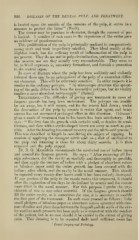Page 906 - My FlipBook
P. 906
916 DISEASES OF THE DENTAL PULP, AND TREATMENT.
is located upon the outside of the remains of the pulp, it serves in a
measure to protect the latter" (Wedl).
The tumor may be purulent in character, though the amount of pus
is limited. A number of such cases in the experience of the writer gave
no evidence of pus-formation.
This proliferation of the pulp is principally confined to comparatively
young teeth and teeth imperfectly calcified. They bleed readily at the
slightest touch, but the ordinary result of inflammation of the pulp is
not present. They do not end in pulp-devitalization, pericementitis, alve-
olar abscess, nor are they usually very uncomfortable. They seem to
be, as Wedl expresses it, secondary formations, and furnish a protection
to the central organ.
In cases of fracture where the pulp has been suddenly and violently
irritated there may be an enlargement of the pulp of a somewhat differ-
ent character. This will be extremely sensitive. In other respects it is
similar to the ordinary polypus. " In microscopic structure this sprout-
ing of the pulp differs little from the insensitive polypus, but its vitality
implies a more abundant nerve-supply " (Salter).
Treatment.—The difficulty of giving any treatment to cases of
fungous growth has long been understood. The polypus can readily
be cut away, but it will return, and for the reason laid down ; under
the destruction of the pulp by arsenic it resists that agent, and henge
success has not warranted prolonged effort in this direction. Coleman ^
gives a mode of treatment that in his hands has been satisfactory. He
says : " We first dose the growth with carbolic acid, to deaden its sensi-
tiveness, and then with a scythe-shaped lancet cut away as much as pos-
sible. After the bleeding has ceased we carry out the nitric-acid process."
This was described at length in considering the subject of capping. It
consists of applying the strongest nitric acid on a disk of cardboard to
the pulp and retaining it there for about thirty seconds. It is then
removed and the pulp capped.
Dr. B. G. Msercklein recommends the continued use of iodine upon
and around the fungous growth. He says : " After removing all for-
eign substances, dry the cavity as carefully and thoroughly as possible,
and then ajiply the tincture of iodine with a pledget of absorbent cotton
or bibulous paper until the entire growth has been covered with the
iodine ; after which, seal the cavity in the usual manner. This should
be repeated every twenty-four hours until it has been entirely destroyed.
If any portion of the pulp in tlie canals resists this treatment, it should
after the expiration often days be devitalized by arsenic and the root or
roots filled in the usual maimer. For this purpose I prefer the oxy-
chloride of zinc to anv other material. If the fungous o-rowth should
nil the entire cavity, as is sometimes the case, it is necessary to modify
the first part of the treatment. In such cases proceed as follows : Take
small pledgets of bibulous paper or absorbent cotton saturated with tinc-
ture of iodine and place them between the fungoid and the walls of the cav-
ity until as much pressure has been made as is consistent with the comfort
of the patient, but in no case should it be carried to the extent of giving
pain. This dressing is to be repeated daily until sufficient room has
' Dental Surgery and Pathology.


